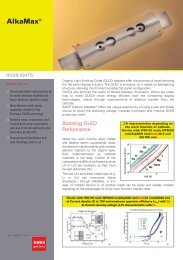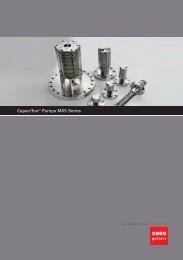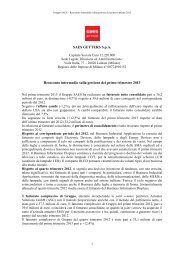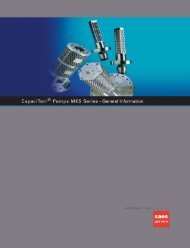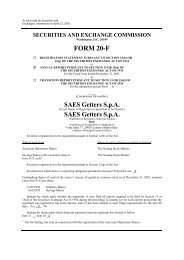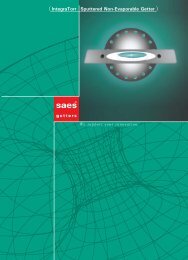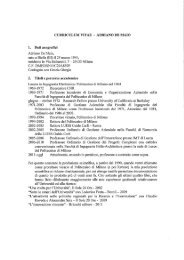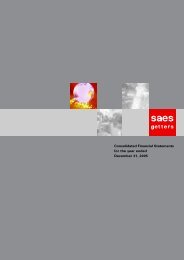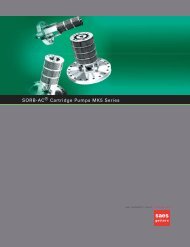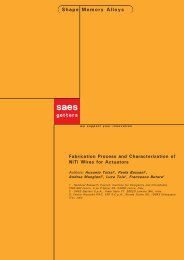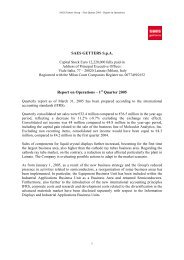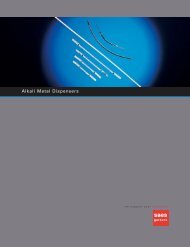Page Brochure 2007.qxp - SAES Getters
Page Brochure 2007.qxp - SAES Getters
Page Brochure 2007.qxp - SAES Getters
You also want an ePaper? Increase the reach of your titles
YUMPU automatically turns print PDFs into web optimized ePapers that Google loves.
<strong>Page</strong> ® Films<br />
we support your innovation
<strong>Page</strong> ® Films<br />
<strong>SAES</strong> ® Thin Film Technology: the Evolution of the<br />
Getter Integration<br />
Pioneering the development of getter technology, the <strong>SAES</strong> ® <strong>Getters</strong> Group is the<br />
world leader in a variety of scientific and industrial applications where stringent<br />
vacuum conditions, ultra-high purity gases or moisture-free environments are<br />
required. For nearly sixty years our getter solutions have been fostering and<br />
supporting technological innovation in the display and lamp industries, in ultrahigh<br />
vacuum systems, in vacuum tube devices, in vacuum thermal insulation and<br />
in hermetic packages. Continuous leading-edge R&D activities, advanced mass<br />
production at high quality standards, worldwide presence in sales and customer<br />
technical support have been key factors in the Group's success.<br />
In order to specifically support the technology trend of increased miniaturization<br />
of electronic devices, such as in Micro Electro Mechanical Systems (MEMS),<br />
<strong>SAES</strong> <strong>Getters</strong> has developed the <strong>Page</strong> ® film product line, consisting of getter<br />
films, a few-microns thick, that can be deposited and patterned on different<br />
substrates in a variety of shapes. <strong>SAES</strong> film getter solutions maintain suitable<br />
operational conditions of the device, either vacuum or inert gas, by keeping<br />
pressure or impurity level, respectively, under control, thus increasing reliability<br />
and lifetime of the final device. Tailor-made getter film composition and deposition<br />
patterns can be developed to meet the customer’s technical requirements.<br />
For the manufacturing of its <strong>Page</strong> films, the <strong>SAES</strong> <strong>Getters</strong> Group is ISO<br />
9001:2000 certified and is committed to implementing a Quality Management<br />
System conforming to the ISO TS 16949:2002 automotive standard.<br />
Customized Solutions for Device Miniaturization<br />
The most common and technically accepted way to maintain a controlled ambient<br />
environment in a hermetically sealed device like MEMS and MOEMS (Micro<br />
Opto Electro Mechanical Systems) is to use a getter capable of chemically absorbing<br />
active gases. The technical solution to these requirements is <strong>SAES</strong> Non-<br />
Evaporable <strong>Getters</strong> (NEG), chemical pumps that absorb active gases, such as<br />
H 2 O, CO, CO 2 , O 2 , N 2 and H 2 .<br />
To support the continuous technology efforts in miniaturizing the packaging dimensions,<br />
the <strong>SAES</strong> <strong>Getters</strong> Group has developed a film technology fully compatible<br />
with MEMS and MOEMS devices: <strong>Page</strong>Wafer ® and <strong>Page</strong>Lid ® are film getter<br />
materials that can be patterned on silicon, glass, metallic or ceramic substrates.
For consumer<br />
industrial and<br />
automotive<br />
applications<br />
Increase<br />
MEMS<br />
performance<br />
stability<br />
<strong>Page</strong>Lid is the way to integrate a <strong>Page</strong> film inside a discrete hermetic vacuum<br />
package. <strong>Page</strong> film can be patterned with different shapes on a variety of commercially<br />
available lid materials, eliminating the need of any handling and welding<br />
of discrete getters. <strong>Page</strong>Wafer is the suitable technical solution to integrate <strong>Page</strong><br />
getter film into wafer-to-wafer bonded MEMS devices, acting as the cap wafer of<br />
the MEMS package. In <strong>Page</strong>Wafer, the getter film is selectively placed inside cavities<br />
with depths ranging from a few to hundreds of microns.<br />
The patented <strong>SAES</strong> technology allows the customization of the pattern of <strong>Page</strong><br />
film, assuring no loose particles and optimal adhesion. Lateral dimensions of a<br />
typical pattern vary from few hundreds of microns to some millimeters.<br />
Contamination-free environments are a key parameter in the manufacturing<br />
process to keep defects under control. A state-of-the-art set up of optical and interferometer<br />
inspection systems is available in <strong>SAES</strong> <strong>Getters</strong>' class 100 cleanroom,<br />
allowing the on-line monitoring of the manufacturing quality standards for<br />
all <strong>Page</strong> materials.<br />
In addition to material analysis and characterization of its own products, <strong>SAES</strong><br />
<strong>Getters</strong> applies in-house analytical skills to customers' materials and devices to<br />
determine outgassing rates and residual gas compositions. A dedicated lab<br />
equipped with state-of-the-art instrumentation offers Residual Gas Analysis (RGA)<br />
and outgassing services.<br />
Class 100<br />
cleanroom
Extended MEMS<br />
lifetime<br />
<strong>Page</strong> Film Competitive Advantages<br />
Performance and stability throughout the device life time<br />
Reduced power consumption in portable devices<br />
Device thermal and mechanical stability<br />
Particle-free<br />
Full customization of the film pattern geometry<br />
Class 100 cleanroom manufacturing<br />
<strong>SAES</strong> Competitive Advantages<br />
Full control of every process step, from in-house manufacturing of raw getter<br />
materials to final wafers testing.<br />
Residual gas analysis lab equipped for direct measurement in sealed hermetic<br />
MEMS packages (detection limit to 10 -6 ccmbar).<br />
Analytical capabilities for the measurements of materials outgassing.<br />
In-house modeling capabilities to support any hermetic package design<br />
(ANSYS).<br />
Sorption test capability according to the ASTM F 798-97 standard.<br />
A global sales & service network, offering dedicated resources and expertise<br />
around the world, to best support customers at any product development and<br />
manufacturing stage.<br />
<br />
RGA vacuum bench<br />
at <strong>SAES</strong><br />
corporate labs<br />
<br />
Pressure<br />
distribution<br />
uniformity after<br />
bonding process<br />
using <strong>Page</strong> Film.
<strong>Page</strong>Wafer ®<br />
HIGHLIGHTS<br />
General Features<br />
Easiest getter integration into<br />
wafer-level MEMS<br />
Compatible with silicon and glass<br />
substrates up to 8” diameter<br />
Composition and thickness<br />
tailored to process and<br />
performance requirements<br />
Highest gas sorption<br />
performance<br />
Homogeneous vacuum pressure<br />
all over the wafer surface<br />
No loose particles<br />
Compatibility with all MEMS<br />
vacuum bonding processes<br />
Allows high Q-value in resonators<br />
and gyroscopes<br />
Applications<br />
Gyroscopes and accelerometers<br />
Infrared sensors<br />
RF devices<br />
Pressure sensors<br />
Resonators<br />
Optical devices<br />
Biomedical devices<br />
Time management crystal devices<br />
we support your innovation<br />
A Key Technology<br />
Low cost and reliability are the main driving forces for the successful<br />
commercialization of Micro Electro Mechanical Systems (MEMS) devices. One<br />
possible way to decrease the cost of MEMS devices is shifting from ceramic<br />
packages down to wafer-to-wafer bonded MEMS, in which the silicon wafer becomes<br />
itself part of the package. <strong>Page</strong>Wafer ® is <strong>SAES</strong> ® <strong>Getters</strong>' technical solution to integrate<br />
the <strong>Page</strong> ® getter film into wafer-to-wafer bonded MEMS devices that need vacuum or<br />
a moisture-free gas-filled environment to operate. <strong>Page</strong> films, with thicknesses down<br />
to a few microns, are the viable and proven way to ensure long term stability of<br />
hermetically sealed devices, because they remove by chemical sorption all active<br />
gases, including H 2 O, O 2 , CO, CO 2 , N 2 and H 2 . <strong>Page</strong>Wafer is a silicon, glass or ceramic<br />
cap wafer with a diameter up to 8", which acts as the cap wafer of the wafer-level<br />
MEMS package. <strong>Page</strong>Wafer’s <strong>Page</strong> film is patterned to fit MEMS designers' specific<br />
requirements. <strong>Page</strong>Wafer does not include any MEMS moving part. <strong>Page</strong>Wafer has<br />
been proven able to increase the Q-factor of a vibrating MEMS structure, by<br />
enhancing the vacuum level and its reliability in the wafer-to-wafer bonded MEMS, at<br />
the same time reduce its power consumption.<br />
A Customized Solution<br />
<strong>Page</strong>Wafer is the most advanced way to integrate<br />
a getter film in vacuum sealed MEMS. It<br />
guarantees that during MEMS device lifetime<br />
there will be no performance drift due to vacuum<br />
degradation, even in harsh environments,<br />
such as automotive applications. <strong>Page</strong>Wafer<br />
contributes to a homogeneous pressure across<br />
the entire wafer area, especially in large diameter<br />
wafers where conductance problems limit<br />
the lowest achievable pressure at the center of<br />
the wafer during the MEMS vacuum sealing.<br />
Wafer-to-wafer<br />
bonded MEMS<br />
The <strong>Page</strong> film is <strong>SAES</strong>’ patented zirconium alloy, whose composition and morphology<br />
are optimized to maximize sorption performance and reduce activation temperature.<br />
Thickness of the getter film is in the range of few microns, depending on the<br />
quantity of gas to be absorbed, while pattern dimensions can be fully customized<br />
from a few hundreds of microns up to millimeters. <strong>Page</strong>Wafer getter film can be patterned<br />
inside cavities with depths varying from a few to hundreds of microns, as well<br />
as on flat wafer surface. A key characteristic of <strong>Page</strong>Wafer is its capability to be activated<br />
during the sealing/bonding process without the need of dedicated activation<br />
steps.
<strong>Page</strong>Wafer Characteristics<br />
The <strong>Page</strong>Wafer film is mechanically stable with respect to temperature cycles (tested<br />
up to 500 temperature cycles from -40 to 150 °C) and it complies with the<br />
semiconductor industry adhesion test (ASTM D 3359-02). <strong>Page</strong>Wafer can be safely<br />
handled in air, as the <strong>Page</strong> film is supplied in a stable, passivated form.<br />
In terms of activation temperatures, <strong>Page</strong>Wafer is compatible with the major waferto-wafer<br />
MEMS bonding techniques such as glass frit, anodic, direct fusion and<br />
eutectic paste bonding processes, as shown in the table below.<br />
Bonding type<br />
Typical pumping speed vs capacity<br />
plots for CO and H 2 (according<br />
to ASTM F 798-97) are<br />
reported in the chart on the<br />
right.<br />
The other active gases, such as<br />
CO 2 , O 2 , H 2 O and N 2 , are<br />
pumped by the <strong>Page</strong> film with<br />
different sorption capacities, as<br />
summarized in the following<br />
table.<br />
Bonding/<br />
activation<br />
temperature<br />
Typical<br />
bonding time<br />
<strong>Page</strong><br />
performance<br />
(a.u.)<br />
Eutectic (AuSn) 300 °C 15’ 1<br />
Anodic 350 °C 30’ 1.5<br />
Eutectic (AuSi) 400 °C 30’ 2<br />
Glass frit 450-470 °C 30’ 2.5<br />
Low temperature direct 450-500 °C 30’ 2.5<br />
<strong>Page</strong> film sorption curves for H 2 and CO<br />
Pumping Speed [cc/s/cm 2 ]<br />
100<br />
10<br />
1<br />
0,1<br />
Getter thickness: 2 micron<br />
Activation: 15 min. at 300 °C<br />
Sorption temperature: 25 °C<br />
According to ASTM F 798-97<br />
0,001 0,01 0,1 1<br />
Sorption Capacity [cc·mbar/cm 2 ]<br />
H2<br />
CO<br />
<strong>Page</strong>Wafer ®<br />
The <strong>SAES</strong> <strong>Getters</strong> Group<br />
manufacturing companies are<br />
ISO9001 certified, the Asian<br />
and Italian companies are<br />
ISO14001certified also. Full<br />
information about our<br />
certifications for each<br />
company of the Group is<br />
available on our website at:<br />
www.saesgetters.com<br />
D.MEMS.33.4<br />
Relative Sorption Capacity<br />
for Different Gases at Room Temperature (a.u.)<br />
CO CO 2 O 2 H 2 O N 2 H 2 Noble gases<br />
1 1 3 6 0.5 >50 N/A<br />
When the <strong>Page</strong> film is operating in hot conditions, as it is during the bonding step, its<br />
sorption capacity for the various active gases is much higher than its capacity at room<br />
temperature (almost two orders of magnitude at 450 °C). This is because the higher<br />
temperature promotes the diffusion of the chemisorbed gases from the surface of<br />
the getter film into its bulk. This higher capacity allows the <strong>Page</strong> to also act as a<br />
“process getter” allowing the sorption of the larger quantity of gases desorbed<br />
during the high-temperature bonding process.<br />
Depending on the bonding process, the <strong>Page</strong> film can be patterned inside bonding<br />
frames of glass frit or eutectic paste. <strong>Page</strong>Wafer also fully withstands standard wafer<br />
chemical cleaning processes, such as megasonic DI water, RCA and HNO 3 cleaning.<br />
<strong>Page</strong>Wafer gas sorption capacity and speed can be customized to any wafer-level<br />
MEMS device, through the adequate sizing of the <strong>Page</strong> film thickness and of the coated<br />
area.<br />
Typical <strong>Page</strong> Film Characteristics<br />
Getter activation<br />
15 min. at 300 °C in vacuum or noble gas<br />
Film density ~6·10 3 kg/m 3<br />
CTE (bulk)<br />
~6·10 -6 m/m/°C<br />
Young’s modulus (bulk)<br />
67 GPa<br />
Stress value at rupture<br />
Electrical conductivity<br />
120 MPa<br />
>20 kS/m<br />
Storage temperature / Shelf life 25 °C / 1 year in dry N 2<br />
© 2007 <strong>SAES</strong> <strong>Getters</strong>. Printed in Italy. All rights reserved. <strong>SAES</strong> ® , <strong>Page</strong> ® , <strong>Page</strong>Wafer ® and <strong>Page</strong>Lid ® are registered<br />
trademarks of <strong>SAES</strong> <strong>Getters</strong> S.p.A., its subsidiaries and affiliates.<br />
<strong>SAES</strong> <strong>Getters</strong> reserves the right to change or modify product specifications at any time without notice.<br />
<strong>SAES</strong> <strong>Getters</strong> Group<br />
www.saesgetters.com<br />
page@saes-group.com
<strong>Page</strong>Lid ®<br />
HIGHLIGHTS<br />
General Features<br />
Easiest getter integration into<br />
discrete MEMS packages<br />
Custom patterning on glass,<br />
ceramic and metal lids<br />
Getter composition and<br />
thickness tailored to customer<br />
requirements<br />
Highest gas sorption<br />
performance<br />
No loose particles<br />
Compatible with all MEMS<br />
vacuum bonding processes<br />
Allows high Q-values in<br />
gyroscopes and resonators<br />
Applications<br />
Gyroscopes and accelerometers<br />
Infrared sensors<br />
RF devices<br />
Pressure sensors<br />
Resonators<br />
Optical devices<br />
Biomedical devices<br />
Time management crystal devices<br />
we support your innovation<br />
A Key Technology<br />
<strong>Page</strong>Lid ® is <strong>SAES</strong> ® <strong>Getters</strong>' advanced technological solution for the integration of the<br />
<strong>Page</strong> ® thin film into discrete hermetic ceramic or metallic packages for vacuum or inert<br />
gas sealed devices, particularly MEMS. It delivers long-term vacuum stability, thus<br />
guaranteeing against any performance drift due to vacuum degradation throughout<br />
the MEMS device lifetime, even in harsh environments such as in automotive applications.<br />
<strong>Page</strong>Lid is <strong>SAES</strong> <strong>Page</strong> film applied to metallic, ceramic, glass or germanium lids in<br />
customer-defined patterns. Direct getter film patterning on the lid avoids welding of<br />
bulk getters into discrete miniaturized hermetic packages, reducing assembly time<br />
and final costs. <strong>Page</strong> film significantly reduces outgassing from the lid, through chemical<br />
sorption of active gases, including H 2 O, O 2 , CO, CO 2 , N 2 and H 2 .<br />
A Customized Solution<br />
<strong>Page</strong>Lid substrates can be any material currently used<br />
for manufacturing lids for hermetic packages, from glass,<br />
germanium, metal or ceramic. <strong>Page</strong>Lid sizes and shapes<br />
can fit any package base, while the <strong>Page</strong> film can be patterned<br />
on the lid, even with a solder preform or glass frit<br />
present. When a transparent central window is required,<br />
the <strong>Page</strong> film can be deposited onto the frame without<br />
affecting the solder preform. <strong>Page</strong> film can also be patterned<br />
onto ceramic plates that are subsequently singulated<br />
into <strong>Page</strong>Lid products. Dimensions of the <strong>Page</strong> film<br />
pattern cells can vary from hundreds of microns up to<br />
some centimeters, while various shapes can be patterned as well (circular, rectangular,<br />
ring-shaped).<br />
<strong>Page</strong>Lid Characteristics<br />
Discrete hermetic<br />
package with <strong>Page</strong>Lid<br />
<strong>Page</strong> film consists of <strong>SAES</strong>' patented zirconium alloy, whose composition and morphology<br />
are optimized to maximize sorption performance and reduce activation temperature.<br />
<strong>Page</strong> film complies with the semiconductor industry adhesion test (ASTM<br />
D 3359-02). <strong>Page</strong> film is also mechanically stable with respect to temperature cycles<br />
used in automotive applications (tested up to 500 temperature cycles from -40 °C up<br />
to 150 °C). <strong>Page</strong>Lid can be safely handled in air, since its getter film is supplied in a<br />
stable, passivated form. It is clean room compatible, since it is particle free. <strong>Page</strong>Lid<br />
is activated during the heating and bonding stage of the sealing process.
<strong>Page</strong>Lid has been proven compatible with the solder preform hermetic bonding<br />
process and the projection welding process, sometimes requiring an additional<br />
activation step at high temperature under vacuum. <strong>Page</strong>Lid absorption capacity for<br />
active gases coming from<br />
outgassing or from possible leaks<br />
can be properly sized to ensure<br />
the device design lifetime. The<br />
gas pumping speed can be tuned<br />
to contribute to evacuation time<br />
reduction when particular<br />
package geometries prevent a<br />
fast package evacuation. Typical<br />
pumping speed vs capacity plots<br />
for CO and H 2 (according to ASTM<br />
F 798-97) are reported in the chart<br />
on the right.<br />
<strong>Page</strong> film sorption curves for H 2 and CO<br />
Pumping Speed [cc/s/cm 2 ]<br />
100<br />
10<br />
1<br />
0,1<br />
Getter thickness: 2 micron<br />
Activation: 15 min. at 300 °C<br />
Sorption temperature: 25 °C<br />
According to ASTM F 798-97<br />
0,001 0,01 0,1 1<br />
Sorption Capacity [cc·mbar/cm 2 ]<br />
The other active gases, such as CO 2 , O 2 , H 2 O and N 2 are pumped by the <strong>Page</strong> film<br />
with different sorption capacities, as summarized in the following table.<br />
Relative Sorption Capacity<br />
for Different Gases at Room Temperature (a.u.)<br />
CO CO 2 O 2 H 2 O N 2 H 2 Noble gases<br />
1 1 3 6 0.5 >50 N/A<br />
H2<br />
CO<br />
<strong>Page</strong>Lid ®<br />
The <strong>SAES</strong> <strong>Getters</strong> Group<br />
manufacturing companies are<br />
ISO9001 certified, the Asian<br />
and Italian companies are<br />
ISO14001certified also. Full<br />
information about our<br />
certifications for each<br />
company of the Group is<br />
available on our website at:<br />
www.saesgetters.com<br />
D.MEMS.72.1<br />
A typical activation requires a minimum of 15 min. at 300 °C. If <strong>Page</strong> film is activated<br />
at higher temperatures or for longer time, its performance is improved as shown in<br />
the table below.<br />
Typical<br />
activation<br />
temperature<br />
Typical<br />
bonding time<br />
<strong>Page</strong><br />
performance<br />
(a.u.)<br />
300 °C 15’ 1<br />
350 °C 30’ 1.5<br />
400 °C 30’ 2<br />
450-500 °C 30’ 2.5<br />
When the <strong>Page</strong> film is operating in hot conditions, as it is during the bonding step, its<br />
sorption capacity for the various active gases is much higher than its capacity at room<br />
temperature (almost two orders of magnitude at 450 °C). This is because the higher<br />
temperature promotes the diffusion of the chemisorbed gases from the surface of<br />
the getter film into its bulk. This higher capacity allows the <strong>Page</strong> to also act as a<br />
“process getter” allowing the sorption of the large quantity of gases desorbed during<br />
the high-temperature bonding process.<br />
Typical <strong>Page</strong> Film Characteristics<br />
Getter activation<br />
15 min. at 300 °C in vacuum or noble gas<br />
Film density ~6·10 3 kg/m 3<br />
CTE (bulk)<br />
~6·10 -6 m/m/°C<br />
Young’s modulus (bulk)<br />
67 GPa<br />
Stress value at rupture<br />
Electrical conductivity<br />
120 MPa<br />
>20 kS/m<br />
Storage temperature / Shelf life 25 °C / 1 year in dry N 2<br />
© 2007 <strong>SAES</strong> <strong>Getters</strong>. Printed in Italy. All rights reserved. <strong>SAES</strong> ® , <strong>Page</strong> ® , <strong>Page</strong>Wafer ® and <strong>Page</strong>Lid ® are registered<br />
trademarks of <strong>SAES</strong> <strong>Getters</strong> S.p.A., its subsidiaries and affiliates.<br />
<strong>SAES</strong> <strong>Getters</strong> reserves the right to change or modify product specifications at any time without notice.<br />
<strong>SAES</strong> <strong>Getters</strong> Group<br />
www.saesgetters.com<br />
page@saes-group.com
Lainate, Italy - Avezzano, Italy -Tortolì, Italy - Cologne, Germany - Weil am Rhein, Germany - Moscow, Russia - Daventry, UK -<br />
Nanjing, P.R. of China - Shanghai, P.R. of China - Tokyo, Japan - Seoul, Korea - Jincheon-kun, Korea - Jhubei City, Taiwan -<br />
Singapore - Cleveland OH, USA - Colorado Springs CO, USA - San Luis Obispo CA, USA<br />
The <strong>SAES</strong> <strong>Getters</strong> Group manufacturing companies are ISO9001 certified, the Asian and Italian companies are<br />
ISO14001certified also. Full information about certifications for each company of the Group is available on the corporate<br />
website at: www.saesgetters.com<br />
© 2007 <strong>SAES</strong> <strong>Getters</strong>. Printed in Italy. All rights reserved. <strong>SAES</strong> ® , <strong>Page</strong> ® , <strong>Page</strong>Wafer ® and <strong>Page</strong>Lid ® are registered trademarks of <strong>SAES</strong> <strong>Getters</strong> S.p.A., its subsidiaries<br />
and affiliates.<br />
<strong>SAES</strong> <strong>Getters</strong> reserves the right to change or modify product specifications at any time without notice.<br />
<strong>SAES</strong> <strong>Getters</strong> Group<br />
www.saesgetters.com<br />
page@saes-group.com



